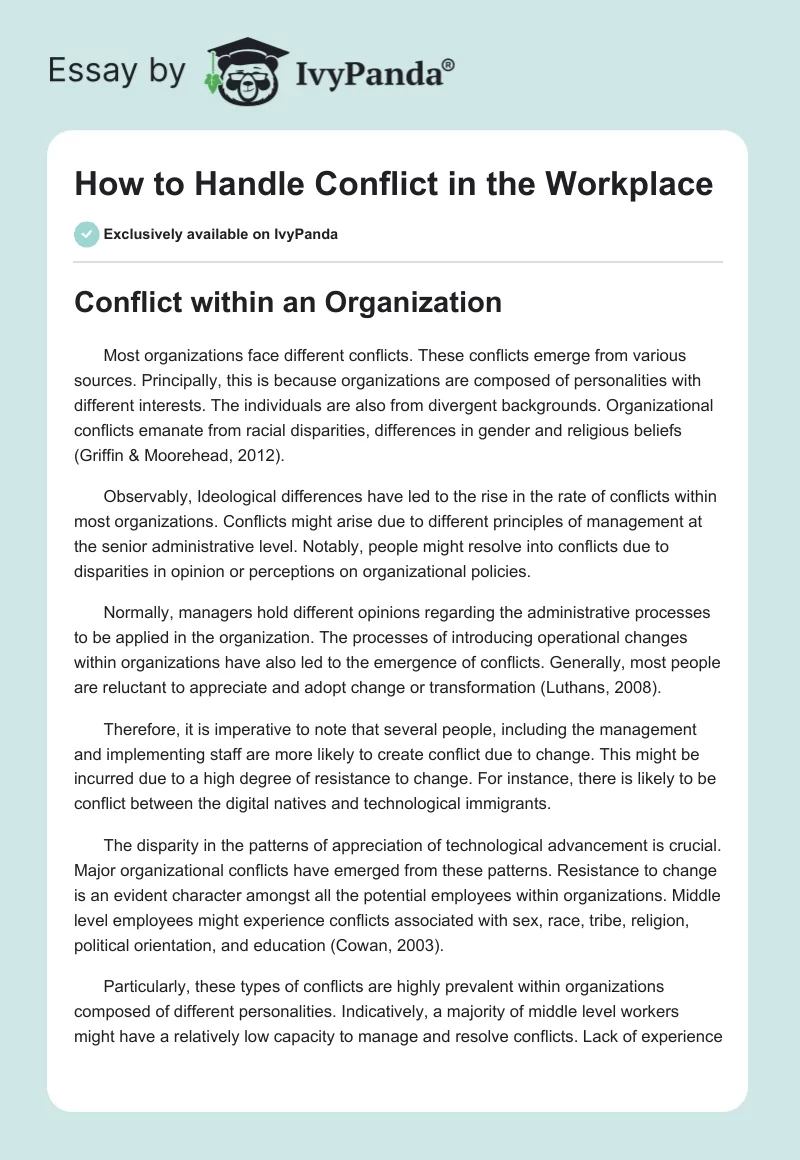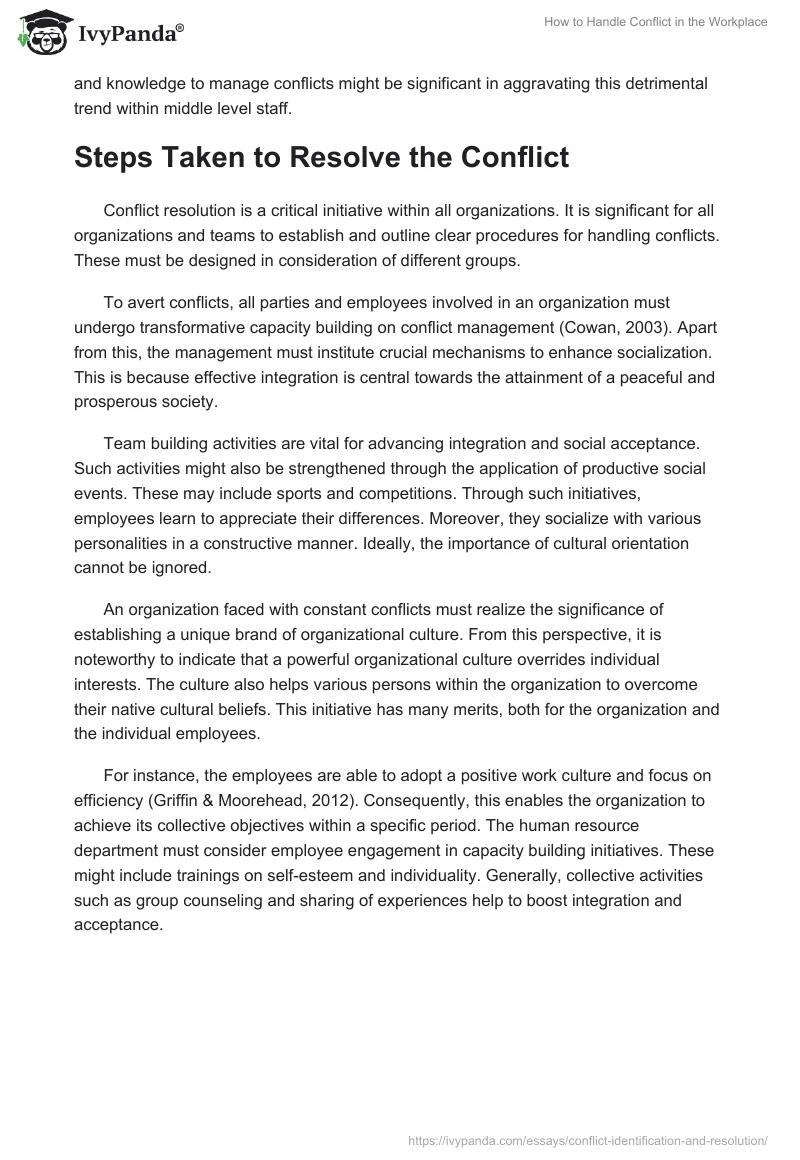Conflict within an Organization
Most organizations face different conflicts. These conflicts emerge from various sources. Principally, this is because organizations are composed of personalities with different interests. The individuals are also from divergent backgrounds. Organizational conflicts emanate from racial disparities, differences in gender and religious beliefs (Griffin & Moorehead, 2012).
Observably, Ideological differences have led to the rise in the rate of conflicts within most organizations. Conflicts might arise due to different principles of management at the senior administrative level. Notably, people might resolve into conflicts due to disparities in opinion or perceptions on organizational policies.
Normally, managers hold different opinions regarding the administrative processes to be applied in the organization. The processes of introducing operational changes within organizations have also led to the emergence of conflicts. Generally, most people are reluctant to appreciate and adopt change or transformation (Luthans, 2008).
Therefore, it is imperative to note that several people, including the management and implementing staff are more likely to create conflict due to change. This might be incurred due to a high degree of resistance to change. For instance, there is likely to be conflict between the digital natives and technological immigrants.
The disparity in the patterns of appreciation of technological advancement is crucial. Major organizational conflicts have emerged from these patterns. Resistance to change is an evident character amongst all the potential employees within organizations. Middle level employees might experience conflicts associated with sex, race, tribe, religion, political orientation, and education (Cowan, 2003).
Particularly, these types of conflicts are highly prevalent within organizations composed of different personalities. Indicatively, a majority of middle level workers might have a relatively low capacity to manage and resolve conflicts. Lack of experience and knowledge to manage conflicts might be significant in aggravating this detrimental trend within middle level staff.
Steps Taken to Resolve the Conflict
Conflict resolution is a critical initiative within all organizations. It is significant for all organizations and teams to establish and outline clear procedures for handling conflicts. These must be designed in consideration of different groups.
To avert conflicts, all parties and employees involved in an organization must undergo transformative capacity building on conflict management (Cowan, 2003). Apart from this, the management must institute crucial mechanisms to enhance socialization. This is because effective integration is central towards the attainment of a peaceful and prosperous society.
Team building activities are vital for advancing integration and social acceptance. Such activities might also be strengthened through the application of productive social events. These may include sports and competitions. Through such initiatives, employees learn to appreciate their differences. Moreover, they socialize with various personalities in a constructive manner. Ideally, the importance of cultural orientation cannot be ignored.
An organization faced with constant conflicts must realize the significance of establishing a unique brand of organizational culture. From this perspective, it is noteworthy to indicate that a powerful organizational culture overrides individual interests. The culture also helps various persons within the organization to overcome their native cultural beliefs. This initiative has many merits, both for the organization and the individual employees.
For instance, the employees are able to adopt a positive work culture and focus on efficiency (Griffin & Moorehead, 2012). Consequently, this enables the organization to achieve its collective objectives within a specific period. The human resource department must consider employee engagement in capacity building initiatives. These might include trainings on self-esteem and individuality. Generally, collective activities such as group counseling and sharing of experiences help to boost integration and acceptance.
Three Conflict Outcomes That Occur Because of Conflict Resolution
There are different conflict outcomes that may emerge from the resolution mechanisms. Foremost, resistance and rebellion might arise from different segments of employees.
This might be notable because not all people accept change processes within an organization. The condition might aggravate the level of conflicts already encountered in the organization (Luthans, 2008). Typically, all human beings behave differently towards specific situations. Resistance is a constant challenge that might hinder conflict resolution mechanisms within an organization.
Therefore, all administrative and management staff must consider the implications of resistance to conflict resolution processes within the organization. Secondly, there is likely to be a reduction in the rate of occurrence of conflicts within the organization. Ideally, proper conflict resolution measures have positive impacts on the subjects. It is upon the responsible staff to ensure that the arbitration measures are taken with proper and urgent concern.
Effective socialization is a fundamental process. It is possible to attain conflict resolution through this process. This is irrespective of the context in which the initiative is implemented. The third outcome of conflict resolution process may be an observable rise in the rate of organizational performance (Griffin & Moorehead, 2012).
Generally, effective results can only be attained through transformative and peaceful work environment. This is the principle objective of a conflict resolution strategy. Specifically, the results are attainable through comprehensive programs. Conclusively, organizations must realize the significance of conflict resolution and harmonious existence. Collective participation and engagement of employees is a critical consideration.
References
Cowan, D. (2003). Taking charge of organizational conflict: A guide to managing anger and confrontation. Fawnskin, Calif: Personhood Press.
Griffin, R. W. & Moorehead, G. (2012). Organizational behavior: Managing people and organizations. Mason, OH: South-Western/Cengage Learning.
Luthans, F. (2008). Organizational behavior. Boston: McGraw-Hill/Irwin.


